Supermassive black holes — cosmic titans with masses of 100,000 to billions of times the mass of the sun — are among the universe’s most fearsome phenomena. These celestial behemoths can consume entire stars and unleash torrents of powerful radiation visible across vast cosmic distances. However, in a recent study, researchers observed something entirely unprecedented: a pair of supermassive black holes devouring an enormous gas cloud that’s unlike any celestial meal scientists have ever seen.
This discovery, made possible by a curious radiation signal, offers new insight into the behavior of these cosmic giants and their relationship with the galaxies they inhabit.
“The light that is emitted from the system shows an oscillatory pattern that is repeated every 60 – 90 days, and this is the first time that this kind of variation is observed in an active galactic nucleus,” Lorena Hernández-García, an astrophysicist at the Millennium Institute of Astrophysics and the University of Valparaíso in Chile and lead author of a new study on the ravenous black holes, told Live Science via email. “This pattern is observed in the X-rays, ultraviolet and optical frequencies, making this system unique.”
Examining the mysterious signal
The signal, designated AT 2021hdr, was first detected in March 2021 by the Zwicky Transient Facility, a powerful ground-based optical survey. It originated from a galaxy known as 2MASX J21240027+3409114, located approximately 1 billion light-years away, in the northern constellation Cygnus.
Related: Astronomers find heaviest black hole pair in the universe, and they’ve been trapped in an endless duel for 3 billion years
At first, scientists suspected the signal might be linked to more familiar phenomena, such as a supernova or a tidal disruption event, which is when a black hole tears a star apart. However, the signal exhibited a highly unusual brightness oscillation pattern not observed in such events. This intriguing anomaly prompted the research team to investigate the signal in greater depth.
“We observed how the light of the system varies with time, for more than four years, using multiwavelength instrumentation,” Hernández-García explained. “The study includes observations with the Swift satellite (X-rays and ultraviolet), Zwicky Transient Facility (optical), Very Long Baseline Array (radio), and optical telescopes in Spain, Mexico and India.”
These observations, which spanned a wide range of wavelengths, confirmed the earlier conclusion that the signal’s origin was unfamiliar. For instance, its X-ray emission was far too intense to be explained by any conventional candidates that the team considered. With no comparable signals to guide them, the researchers turned to theoretical models to solve the mystery. They hypothesized that the radiation was produced by a pair of supermassive black holes consuming a massive cloud of galactic gas — a scenario previously explored through computer simulations.

Based on the simulation of the black holes’ interaction with each other and with a gas cloud, the team found that the signal they studied fits well with the predictions of the computer model — if the supermassive black hole pair and gas cloud have particular properties.
“After a detailed comparison with theoretical models, we conclude that the light emitted by the system can be explained by a binary supermassive black hole interacting with a gas cloud roughly equivalent in mass to the Sun,” Hernández-García said. “In this scenario, the two black holes would be separated by 0.8 milliparsecs (roughly one light-day), orbit each other approximately every 130 days, have a combined mass of about 40 million solar masses, and are expected to merge in roughly 70,000 years.”
Future directions and perspectives
Although the AT 2021hdr signal fits neatly within the team’s hypothesis, additional observations of similar systems will be necessary to solidify their conclusions. Future data will help refine models of how supermassive black holes behave when consuming galactic gas.
“We need to confirm the scenario that we are proposing, so we need to collect new data and perform simulations using these data in order to probe our hypothesis,” Hernández-García said.
If validated, the discovery could transform how astronomers study supermassive black holes by offering a new method to investigate their evolution and their role in shaping galaxies. These massive objects are closely linked to their host galaxies, and learning more about their feeding habits could provide fresh insight into galactic development.
“Finding binary supermassive black holes is a challenging task, but from the theoretical point of view it is expected to be present in many galaxy centers,” Hernández-García explained. “The fact that we cannot resolve the two black holes with the available instrumentation imply that we need to find alternative techniques to detect them through other methods. Finding more like this will allow us to study how galaxies merge and evolve with time.”
